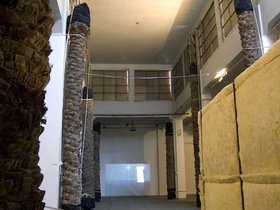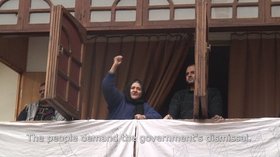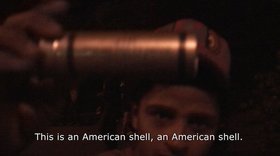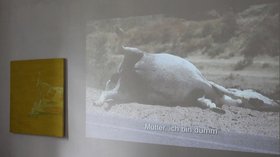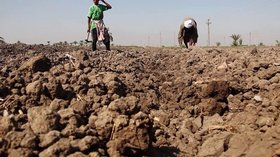Interviews
Active Interventions/ Intervening Actions
Jasmina Metwaly in conversation with Angela Harutyunyan
Artist Jasmina Metwaly was born in Poland and grew up between Warsaw and Cairo. She moved to Cairo in 2009 and took part in the group exhibition Paradise Paradise at the Townhouse Gallery's factory space in 2010. Since then, and following the revolution that ousted President Hosni Mubarak in February 2011, Metwaly has been working with social media collective Mosireen and filmmaker Philip Rizk, to promote video activism and document unrest. In a conversation with art historian Angela Harutyunyan, Metwaly discusses the ambivalence of artistic production in the context of ongoing unrest and responds to what it means to be an artist working with the grammar of activism and against the backdrop of post-revolutionary Egypt.
Angela Harutyunyan: You had your first exhibition in Egypt in 2010, in collaboration with three other artists from Poland, and just after you had relocated to Cairo following your graduation from the Academy of Fine Arts in Poznan. Titled Paradise Paradise and held at Townhouse Gallery’s factory space, the show revealed specific conceptual concerns that arise from the tension between the quotidian and the extraordinary, fixed meaning and its subsequent bankruptcy, everyday materials and their poetic adaptations. This was your entrance into the Cairo art scene. Since then, many rivers have flown both in terms of the shifting artistic landscape and drastically changing political constellations. In post-Mubarak Egypt, many artists have attempted to reconfigure their practice in relation to political events. Several of them are unable to produce art when there is violence on the streets and structural violence in everyday life. Yet there are also artists whose work was not marked by formal or conceptual shifts: they remain politically active citizens, while at the same time are reluctant to create art works that respond to the political situation in Egypt. Where do you see, or don’t see yourself, within these categories?
Jasmina Metwaly: When I first arrived in Egypt, the situation was different for me personally, as I was relocating to Cairo from Poznan and London, where I was involved in ongoing exhibitions and artistic projects. The 2010 show at Townhouse Gallery’s factory space was part of what I had already started. The exhibition was rather spontaneous and quick, but afterwards it took me a while to adapt to the new place and to find myself here. Eventually, after acquiring a studio space, I started working on paintings and videos. It felt that I was beginning a new chapter in my life. The move to Egypt was challenging as it halted an artistic process that I had already started. Working at the factory space intersected with a desire to go back to my roots, but it was also informed by a simple curiosity. It was a test for me to find out whether I could live in Egypt.
I got more and more involved in the political situation in Egypt, before the revolution. I started researching a socially oriented film project in Fayoum, with filmmaker and anthropologist Philip Rizk. I had an urge to respond to the situation in Egypt, and I could not provide an adequate response with my practice as an artist if I wanted to scrape beneath the surface. Besides, I wanted to address a different audience than those who frequent art openings. I wanted to respond to people’s needs, not as an artist but as someone who lives here. This is when I found out that documentary is the closest genre for my specific purposes. I was not interested in creating yet another film that described and documented social and political issues in the country and got screened in film festivals. Our dilemma was and is how to resolve issues without simply representing them through the tools of documentary filmmaking. I found myself producing various works that were not related to my artistic practice in any way, and I was content with this. But at the same time I stopped being engaged with aesthetic questions that were important to me personally. The more I got into videography and activism, the more detached I became from my earlier practice. I started using my skills in video production to get actively involved in videography and social media. I started working with Mosireen, a social media collective that archives footage, organizes workshops in film production for amateurs, and provides a platform for videographers to share their work.
AH: Could you describe some of the specific social and political concerns that informed your work as a videographer? And how do you use documentary filmmaking as a tool for intervention rather than simply as a medium for representing a finished product or a resolved argument?
JM: Our main target at the moment is the Supreme Council of the Armed Forces, and it has been our preoccupation since the 28 January 2011 and beyond, especially after we discovered the widespread military trials for civilians in February 2011. This is when we discovered that civilians were being tried without the presence of a lawyer and without being able to exercise their full rights as citizens; they were often detained from their houses, from protests and the streets and given six months to 15-year sentences. The rupture between reality and the way it was distorted and misrepresented on state television prompted us to find alternative means for portraying reality on the ground. We knew that despite the downfall of Mubarak, structural changes would only take place if we kept on fighting for them. If you recall, 25 January was the state-sanctioned celebration of the Police Day, which turned into a protest against a corrupt police state. However, and subsequently, the protests focused too much on stripping Mubarak of his power, forgetting that it is the existing structures that are responsible for an entire corrupt regime and not the father figure alone. With Mubarak’s resignation, it was the army that came to carry out the President’s former functions and protect a regime that continued to function with the same logic of oppression and exploitation.
It was in March 2011, after the army cleared the sit-in in Tahrir, that Philip and I started to collaborate with the ‘No to Military Trials for Civilians’ group. I began collecting testimonies from the victims. The Maspero events in October, where a number of Coptic Christians were killed by the army, were followed by the army driving its vehicles into protesters, which was then followed by the violent clashes on Mohammed Mahmoud Street in November and the Occupy Cabinet sit-in in December.
It is difficult to remain one step ahead. We end up responding to an already constructed situation. We try to build awareness of what is happening through various online blogs or television. However, the latter is very difficult since the mainstream media is still under governmental control. The independent media on the other hand – with the exception of a few talk show hosts – are commercially driven and not really interested in the hard reality on the ground.
It is within this context that I came to question what my practice constitutes: can I still work as an artist? What does it mean in relation to activism? I had to make certain choices, and I chose to suspend my art practice for a while in the face of an urgency to participate and document an ongoing protest movement. This way, I made a conscious decision also not to contribute to the new trend of producing works about the revolution that emerged right after Mubarak’s resignation.
AH: There seems to be an emerging cultural industry that demands revolutionary content. How do you relate to those practices that deal with the current political context in Egypt where content can be displayed, monumentalized and romanticized? It seems to encourage art production that does not treat the event as a constantly unfolding phenomenon, but as an already fossilized moment of history that reached its victorious culmination on 12 February.
JM: Whether I like the works or not, whether we can call them art or not, I believe that any event that gathers people from the street to watch videos about the revolution and discuss them afterwards, is a positive phenomenon. However, I am not comfortable with the production of art objects or works with a revolutionary content and their eventual exportation. These are simply illustrations that represent but do not show anything, since the lived experience cannot be conveyed in these forms. For me, it is not art’s role to become a mirror to events. You can experience them, reflect on them and later on they will indirectly and implicitly find a way into the artwork but there has to be a temporal distance between the event and the artistic work. I am also thinking about Poland where I come from, where various anti-repressive creative practices were evolving underground during the communist era. Having the courage to remain truthful to your positions and beliefs was already a political act. As an artist, you don’t have to adopt a moral position and point at what is right or wrong. The mass media is already doing just that, one way or another. Art needs to be metaphoric, poetic and even magical. Works that deal with the memory of trauma, collective experience and history have been a subject for many artists, but it should go from inside (subjective) out (towards the collective), not the other way around. I am thinking of Miroslaw Balka here, whose art carries the weight of history, but also gives one a space for reflection.
AH: Even though you have not been engaged with your artistic practice in the past year, you presented an artwork at Cairo Documenta 2 comprised of two monochrome yellow canvases facing each other and covered by stains and dust, combined with a single-channel video of a dead donkey on the road juxtaposed with quotes from Nietzsche. Could you tell us more about this work?
JM: This work in part is an exploration of my interrupted practice. When nothing really happens, a monochrome turns into a surface, over time collecting dust and prints from the surrounding reality. It does not say anything. There is no narrative. It is decomposing. One of the monochromes represents a fragment of an image, an element imitating a still from the video projected next to it. It exists in the form of a sketch that attempts to illustrate reality, but fails to do so as a concept.
The inability to show, metaphorically speaking, is a condition when one’s heart stops and there is a flat line on the cardiographic scan. The last sentence is a quote from Nietzsche, ‘Mother I am dumb’, which he spoke soon after throwing himself around a horse’s neck to protect it from the blows of its owner. It conveys the idea of Nietzsche's eternal return. We don't know what happens to the horse. The animal remains in a frozen image, looped in time. The body of the decomposing donkey and the narrative (the subtitled story) alternate without providing any further explanation. The image of the decomposed donkey, seemingly frozen, appears to be flattening to the surface of the ground. The last words, ‘Mutter ich bin dumm’, are flattened to their meaning – and then everything starts again, collecting dust.
AH: I have observed that your work in Cairo Documenta 2 feels as if it is caught up between being a document or testimony without an immediately obvious social message and a poetically frozen image. How does the image of the dead donkey appear? Where does it come from and where will it go?
JM: I am working on a documentary project on the politics of water distribution in Fayoum with Philip Rizk. The first time we visited Tahawy, a village in Fayoum, we spent an entire day filming a place that had no water. It was a chaotic day, people were busy with their daily occupations, and in this environment we felt like intruders, not in a sense of being unwelcome, but in a sense of being alien. We met a group of farmers who could not cultivate their lands because the water is primarily channeled to support development geared towards tourism and upper class housing. This is a local issue specific to Tahawy, but it is also a global problem, touching Palestine, Latin America and other parts of the globe. A farmer in Palestine told me that he could hear water running under the soil that he needed to cultivate, but he had no access to it because the water had been re-channeled towards the Israeli settlements. He could hear it buried underground, but could never see it or enjoy its fruits.
After spending the whole day in Tahawy and driving towards the village of Tunis in September, I saw a dead donkey lying on the ground and filmed it. The work at the exhibition helped me think about my practice and the way I can position myself in the current political context. The images I showed in the exhibition, along with other dozens of images are left-over images; images that are not part of the plan but are accidental. Géricault borrowed human remains from the morgue and then carefully studied them. A dead body is stripped of its past. What we look at are the remains, and the study occurs with the slow movement of the camera. The camera (eye) is turned into a tool, carefully registering and studying the body-parts. The time structure is important. We know nothing about the before and after, making the audience vulnerable and subject to a study that has already occurred.
AH: Perhaps, after all, the demarcation line between the political impact of documentary filmmaking and the impact of a dead donkey left abandoned on the road, is not that marked. They are different, but yet, perhaps similar.
JM: The line is there, sometimes it is clear, and at other times it is not. This work is political in terms of the reality it depicts, but the form it takes and the language it uses can provoke different interpretations. I imagine a farmer’s wife from Tahawy coming to visit this exhibition. Perhaps the image of a dead donkey on the road would take her back home, and that’s fine. I am interested in the difference in reaction between when one looks at the reality itself and when one looks at its representation.
I think that both documentary and art could create a similar response or feeling to image, but the line gets thicker when the dead donkey’s image is taken to a different context. I can afford the work in the context of the gallery, but through my documentary practice, I want to produce a direct applied message without ambiguity, a message to reach as many people as possible. Any metaphors would have to serve this message.
AH: There is an opinion that the revolution is not showing any signs of being translated onto the cultural scene in Cairo. The same institutional politics as well as the politics of visibility are being played out, both in the public art sector and in the so-called independent art scene and art market. The age-old hierarchies persist and certain desired and demanded images and subjectivities are circulated both locally and internationally. Do you see any shifts or changes here?
JM: It is time to cut the umbilical cord both from the rigid public structures and the international art market, and projects such as Cairo Documenta permit that. Of course, the participating artists are not entirely independent: we all have strings attaching us to other artists and to institutions. It is important to create spaces in which it is not the dominant structures that determine the makeup of the event, but the event that becomes the artists’ initiative, regardless of availability of funds or institutional oversight. There are also institutions that respond to the scene, and in Egypt it is still possible to take risks and not compromise one’s practice. Art is doing well. There will be a time when the art scene will explode with works, but this won’t be a direct, reactionary and responsive explosion. It has to come from under one’s skin, it has to be felt and experienced. It can’t happen from the outside and be immediately reflected in art practice. Videos I make in the realm of activism are also about remembering, taking notes and making observations.
Jasmina Metwaly is a visual artist based in Cairo, Egypt. She was born in Warsaw, Poland, in 1982 and completed an MA at the Academy of Fine Arts in Poznan, Poland in 2006, followed by a Postgraduate Diploma at the Byam Shaw School of Art at Central Saint Martins in London, after which she held exhibitions at the Concourse Gallery, Byam Shaw, Kings Gate and the Islington Arts Factory. In 2009, Metwaly moved to Cairo and in 2010, exhibited work at the Townhouse Gallery's Factory Space. In the same year, she won The Open Prize for Video Painting.

